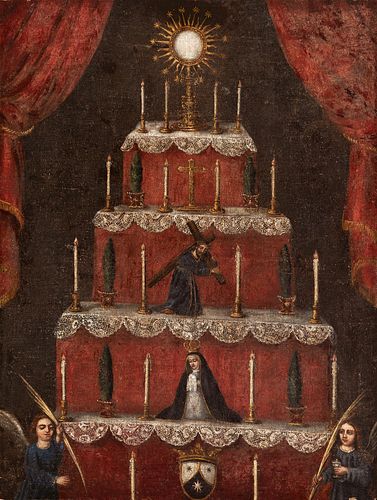Novohispanic School; late seventeenth century. "Altar with Virgin of Solitude and Christ custody". Oil on canvas. Relined.
Lot 73
About Seller
Setdart Auction House
Carrer Aragó 346
Barcelona
Spain
Setdart Subastas was born in 2004 and is currently the first online art auction in Spain with solidity, prestige and reliability guaranteed by our more than 60,000 users. Setdart has a young, dynamic and enterprising team ready to successfully manage the purchase and sale of art works through custom...Read more
Estimate:
EUR€2,000 - EUR€3,000
$2,173.91 - $3,260.87
Absentee vs Live bid
Two ways to bid:
- Leave a max absentee bid and the platform will bid on your behalf up to your maximum bid during the live auction.
- Bid live during the auction and your bids will be submitted real-time to the auctioneer.
Bid Increments
| Price | Bid Increment |
|---|---|
| EUR€0 | EUR€10 |
| EUR€200 | EUR€25 |
| EUR€500 | EUR€50 |
| EUR€1,000 | EUR€100 |
| EUR€3,000 | EUR€200 |
| EUR€5,000 | EUR€500 |
| EUR€10,000 | EUR€1,000 |
| EUR€20,000 | EUR€2,000 |
| EUR€50,000 | EUR€5,000 |
About Auction
By Setdart Auction House
Nov 3, 2021
Set Reminder
2021-11-03 08:00:00
2021-11-03 08:00:00
America/New_York
Bidsquare
Bidsquare : OLD MASTERS
https://www.bidsquare.com/auctions/setdart-auction-house/old-masters-7786
Setdart Auction House sofia@setdart.com
Setdart Auction House sofia@setdart.com
- Lot Description
Novohispanic School; late seventeenth century. "Altar with Virgin of Solitude and Christ custody". Oil on canvas. Relined. Measurements: 97 x 74 cm. The author conceives this work in a theatrical way, by placing the main scene on a completely dark background, which is delimited by two red curtains. These curtains open to an interior dominated by the presence of a stepped altar, similar to the aesthetics of the most frequent altars in Portugal. In the lower area, two little angels guard the scene, each of them located on one side. At the base of the red altar, the shield of the Carmelites stands out, supporting the weight of the Christian tradition. In the central zone the figure of the Virgin, kneeling, located in the center, flanked by candles and vegetal elements. It is Our Lady of Solitude, a variant of advocation of the Virgin Mary of the title of Our Lady of Sorrows. The model, instituted by Gaspar Becerra in his Virgen de la Soledad del convento de la Victoria, gave rise to a characteristic and uniquely Spanish iconography of this advocation that spread throughout the Christian world. However, it has its roots in the diffusion throughout Europe of the cult of Our Lady of Sorrows, since the Solitude of Mary is the last of the Seven Sorrows of the Virgin Mary. The third floor of the altar has the figure of Christ, on Calvary, holding the cross, and finally, located in the upper area, a large golden monstrance. It is worth mentioning that, during the Spanish colonial domination, a mainly religious painting was developed, destined to Christianize the indigenous peoples. The local painters were modeled on Spanish works, which they followed literally in terms of types and iconography. The most frequent models were the harquebusier angels and the triangular virgins, however, in the first years of the 19th century, already in times of independence and political opening of some of the colonies, several artists began to represent a new model of painting with its own identity.
- Shipping Info
-
In-house shipping available. Please inquire at admin@setdart.com.
-
- Buyer's Premium



 EUR
EUR CAD
CAD AUD
AUD GBP
GBP MXN
MXN HKD
HKD CNY
CNY MYR
MYR SEK
SEK SGD
SGD CHF
CHF THB
THB














